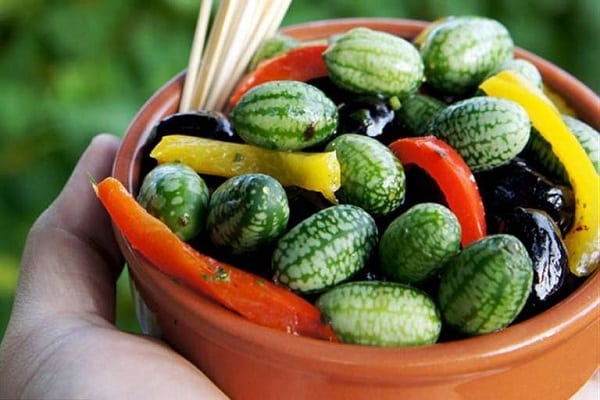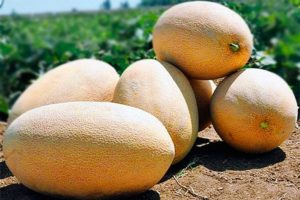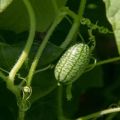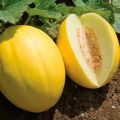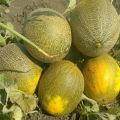Description of Melotria rough (mouse melon), benefits and harms, especially cultivation and care
Exotic plants are increasingly found in summer cottages. Melotria rough is one of them, but it is interesting not only for its originality. Melotria is edible and has health benefits as well.
Exotic in the garden
You understand that Melotria is a distant relative of our garden pumpkin plants, when you learn the second name of exotic - mouse melon. This is a vine that grows in the wild in Africa. Melotria belongs to the pumpkin family, loves the humidity of the tropics. Our gardeners have learned to grow african cucumber in greenhouses, apartments, open ground.
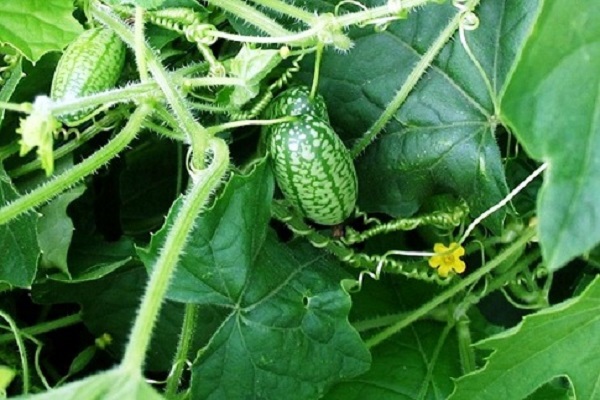
Liana is covered with triangular leaves, their color is rich, bright green. African women can be up to 3 meters long, which is impressive. Melon fruits are miniature from 1.5 to 2 cm. They look like miniature cucumbers in oval shape, covered with tough skin with bright stripes.
Council. Harvest mini cucumbers every 2–3 days. Hanging on the whip, they become sweeter.
Melotria has male and female flowers of small size, funnel-shaped, yellow color. Female flowers are single, male flowers are grouped in bunches. Melotria pleases with fruits in July. Mouse melon tastes like cucumber, but sour.
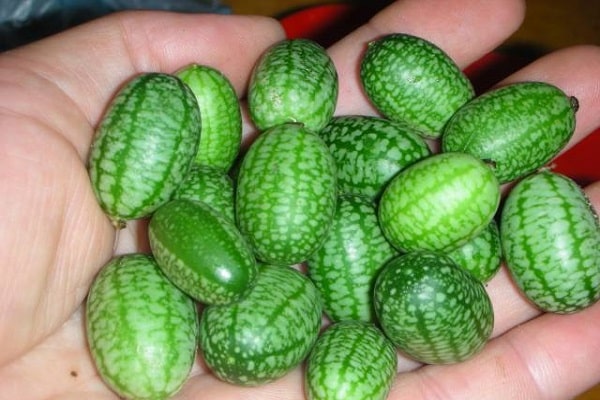
The decorative qualities of mouse melon make it attractive to landscape designers. Liana decorates not only apartments, but also offices. The productivity of Melotria is high. The collected fruits are eaten, they are successfully treated for various diseases. The benefits of cucumbers are determined by their chemical composition.
Description of the composition
In the sourish pulp of Melotria, they found many useful trace elements. A cucumber has all the substances we need:

- phosphorus;
- iron;
- calcium;
- magnesium;
- potassium.
Scientists have found vitamins (B9, PP) important for the human body in the melon pulp. Nutritionists calculated the calorie content of exotic cucumbers, it is 14 Kcal per 100 g of product.
Reference. An interesting fact - the flesh of Melotria is very watery, but in terms of protein content it exceeds the classic cucumbers.
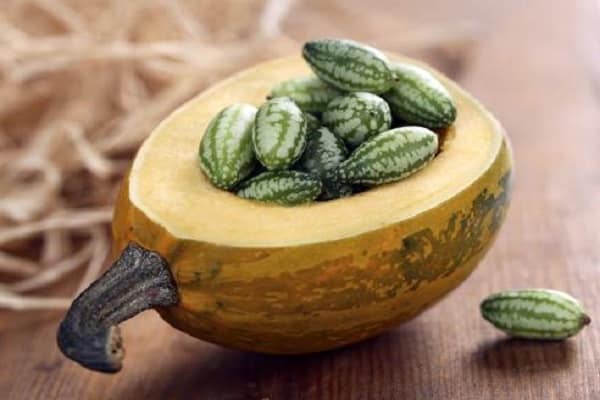
African cucumbers are included in the menu during fasting days. Other beneficial properties of cucumber are used to prevent diseases.
Beneficial features
Melon pulp contains fiber, which is beneficial for the intestines and cardiovascular system. You need to consume mini melon daily to experience the healing effect. There are benefits and certain harm from Melotria rough:

- the pulp of striped African cucumbers is eaten to prevent cancer;
- prolonged use of the fruit leads to the normalization of blood pressure;
- in people with gallbladder problems, bile flow is easier.
The main direction of using Melotria rough - fight against excess weight. With its help, you can keep your weight normal. The fruit of the mouse melon quickly creates a feeling of fullness, which helps to avoid overeating.
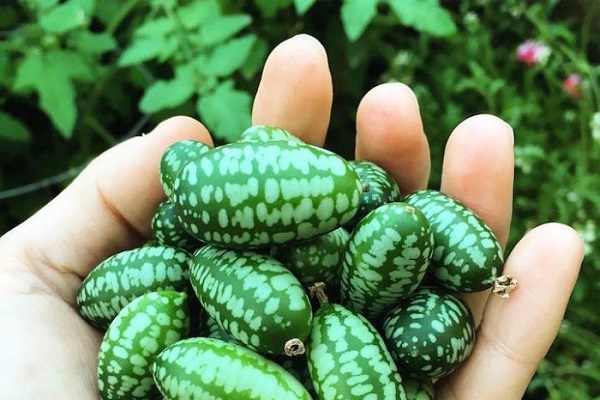
During the diet, melon can be safely included in the diet, it contains few calories. Nutritionists advise doing two fasting days per week. During these days, the diet may consist of African cucumbers, red peppers, and tomatoes. For dressing salads, it is recommended to use kefir, but low-fat. After fasting days, swelling decreases, the work of the digestive tract improves, and constipation does not torment.
Contraindications
Not everyone can eat fresh fruits of Melotria rough. They are contraindicated for people with a sick stomach. Young African cucumbers are eaten fresh. Ripe fruits are used to make blanks. Pickled melon is not recommended for people:
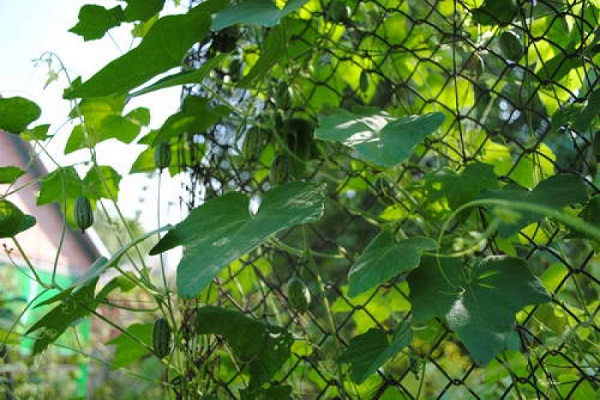
- with a sick heart;
- with liver pathologies;
- with kidney disease;
- with atherosclerosis;
- with hypertension.
It is forbidden for pregnant women to eat pickled exotic.
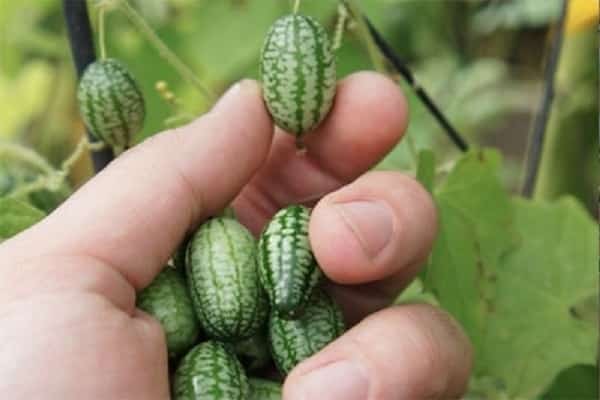
Growing features
When planning to grow Melotria rough, they adhere to the usual rules of caring for classic cucumbers, the agricultural technology of these two crops is similar. Melon is thermophilic; in the open field it is propagated only through seedlings.
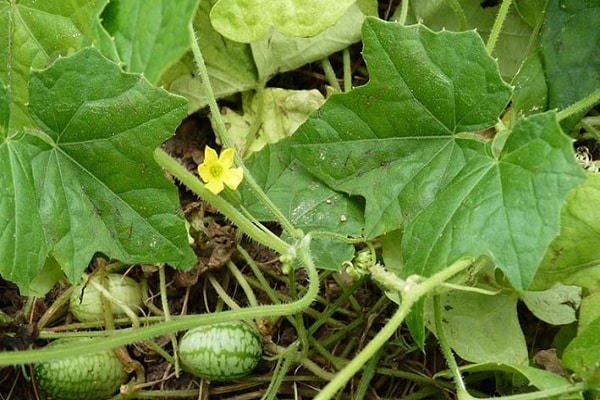
Seedling
For sowing seedlings, take glasses with a volume of 200 ml. A nutritious soil mixture is used as a filler. The soil is moistened, the seeds are not buried deeply, they are very small. The thickness of the soil above the seeds does not exceed 0.5 cm.
We create greenhouse conditions for better germination of Melotria seeds:
- cover the box with melon with foil;
- put in a warm place;
- choose solar windows.

The first sprouts of the melon will hatch in 3-4 days. We remove the film and when the sprouts reach 5 cm, we begin to harden the seedlings. To do this, we do airing using the vents. At home, melon seedlings live until mid-May.
Landing
We pay special attention to the selection of the site for the mouse melon. Its characteristics are important:

- illumination;
- the presence of drafts;
- predecessors.
We focus on sunny places without drafts. Vegetable crops from the list are considered good predecessors to the African cucumber:
- tomatoes;
- beans;
- peas;
- onion.
Bad predecessors for African cucumber: squash, cucumbers, squash, pumpkin. Some gardeners sow Melotria seeds directly on the ridge. There is only one plus from this - saving time for growing seedlings.
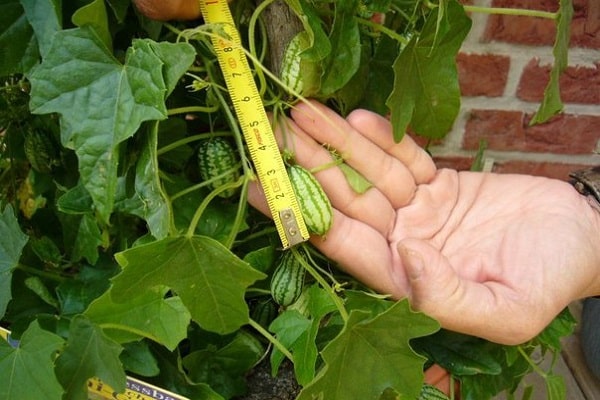
There are more cons: late fruiting, developmental delay. If Melotria is used as an ornamental plant, then it can be propagated by seeds into the ground. In temperate climates, a hybrid of Melotria rough - Hummingbird F1 is grown, actions when planting:
- when landing on a ridge, adhere to the 40x40 cm scheme;
- immediately install the supports in the form of a trellis;
- pour cucumbers.
Further care like classic cucumbers.
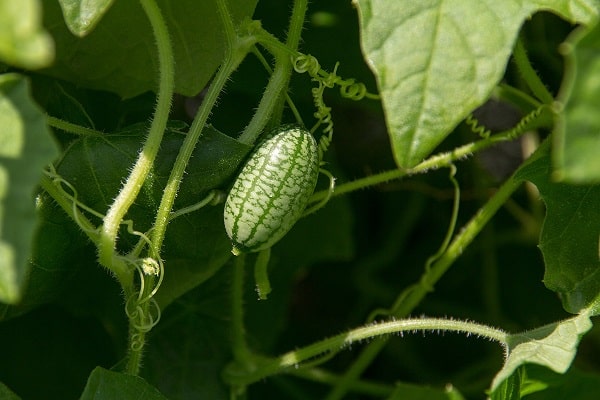
Care
Water Melotria at intervals of 2 days. Pour at least 1 bucket onto one bush. The next day, loosen the ground. The absence of a crust on the ground improves root nutrition. All summer you need to observe the condition of the cucumbers. In case of signs of illness, treat with soapy water.
Urea is used from top dressing in summer. Nitrogen fertilizing increases the growth of green mass of Melotria at times. The first cucumbers will form 14 days after transplanting. At the age of one week, the fetus can be removed. If the harvest is delayed, the crop will lose market value. The African cucumber overrides quickly.
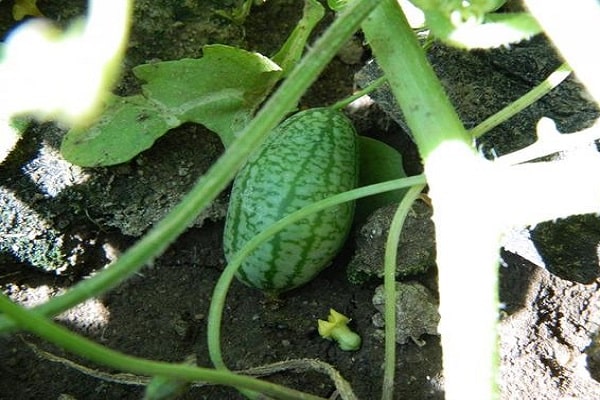
Reviews
Reviews best characterize new, unusual plants. After reviewing them, decide whether you need such an exotic as Melotria in the garden or not.
Petr, Donetsk:
“I was surprised when in an ordinary flower shop in our city I came across the seeds of an exotic plant Melotria rough. I bought the seeds. The goal was to decorate the gazebo. The result was worth the trouble of growing mouse melon.The gazebo was in bright green all summer. "

Elena, Tambov:
“Friends strongly recommended planting an African cucumber. Planted a melon into round holes. She looked after cucumbers. Many fruits have grown, but small. I didn't like the taste, I ate mini-cucumbers on fasting days. They write the truth about leaving excess weight, I have lost weight. "
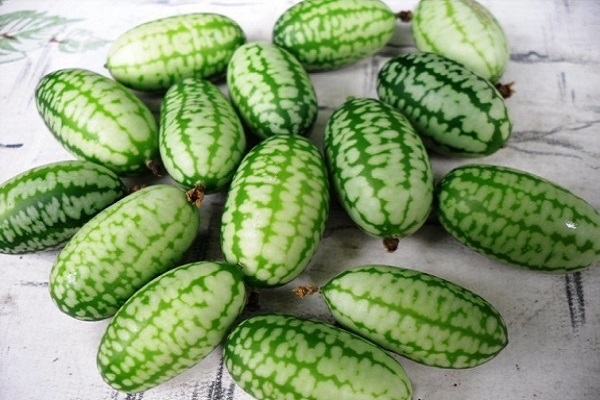
Andrey, Tuapse:
“I planted an African woman with seeds in a hole near the pillar. The post also wanted to decorate a piece of the old fence. All the seeds have sprouted. I didn’t care about any special care: I watered and loosened. I didn't like fresh melons at all. I added them to marinades, they turned out well. The neighbor ate the melons raw and praised them. "
